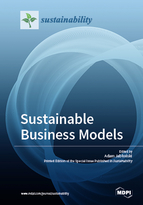Sustainable Business Models
A special issue of Sustainability (ISSN 2071-1050). This special issue belongs to the section "Economic and Business Aspects of Sustainability".
Deadline for manuscript submissions: closed (31 December 2015) | Viewed by 295692
Special Issue Editor
2. OTTIMA Plus, 40-594 Katowice, Poland
Interests: business models; strategic management; sustainable business; performance management; social and digital economy; railway transport
Special Issues, Collections and Topics in MDPI journals
Special Issue Information
Dear Colleagues,
The dynamically changing world economy, in an era of intensive development and globalization, creates new needs in both the theoretical models of management and in the practical discussion related to the perception of business. Because of new economic phenomena related to the crisis, there is a need for the design and operationalization of innovative business models for companies. Due to the fact that in times of crisis, the principles of strategic balance are particularly important, these business models can be sustainable business models. Moreover, it is essential to skillfully use different methods and concepts of management to ensure the continuity of business. It seems that sustainable business models, in their essence, can support companies' effectiveness and contribute to their stable, sustainable functioning in the difficult, ever-changing market.
This Special Issue aims to discuss the key mechanisms concerning the design and operationalization of sustainable business models, from a strategic perspective. We invite you to contribute to this issue by submitting comprehensive reviews, case studies or research articles. Papers selected for this Special Issue are subject to a rigorous peer review procedure, with the aim of rapid and wide dissemination of research results, developments, and applications.
Dr. Adam Jabłoński
Guest Editor
Manuscript Submission Information
Manuscripts should be submitted online at www.mdpi.com by registering and logging in to this website. Once you are registered, click here to go to the submission form. Manuscripts can be submitted until the deadline. All submissions that pass pre-check are peer-reviewed. Accepted papers will be published continuously in the journal (as soon as accepted) and will be listed together on the special issue website. Research articles, review articles as well as short communications are invited. For planned papers, a title and short abstract (about 100 words) can be sent to the Editorial Office for announcement on this website.
Submitted manuscripts should not have been published previously, nor be under consideration for publication elsewhere (except conference proceedings papers). All manuscripts are thoroughly refereed through a single-blind peer-review process. A guide for authors and other relevant information for submission of manuscripts is available on the Instructions for Authors page. Sustainability is an international peer-reviewed open access semimonthly journal published by MDPI.
Please visit the Instructions for Authors page before submitting a manuscript. The Article Processing Charge (APC) for publication in this open access journal is 2400 CHF (Swiss Francs). Submitted papers should be well formatted and use good English. Authors may use MDPI's English editing service prior to publication or during author revisions.
Keywords
- sustainable business models
- green business models
- sustainable strategy
- corporate social responsibility vs. value-based management
- sustainable performance management
- business continuity
- sustainable value
- innovation management






